The Skylake Core i3 (51W) CPU Review: i3-6320, i3-6300 and i3-6100 Tested
by Ian Cutress on August 8, 2016 9:00 AM ESTLinux Performance
Built around several freely available benchmarks for Linux, Linux-Bench is a project spearheaded by Patrick at ServeTheHome to streamline about a dozen of these tests in a single neat package run via a set of three commands using an Ubuntu 11.04 LiveCD. These tests include fluid dynamics used by NASA, ray-tracing, OpenSSL, molecular modeling, and a scalable data structure server for web deployments. We run Linux-Bench and have chosen to report a select few of the tests that rely on CPU and DRAM speed.
All of our benchmark results can also be found in our benchmark engine, Bench.
C-Ray: link
C-Ray is a simple ray-tracing program that focuses almost exclusively on processor performance rather than DRAM access. The test in Linux-Bench renders a heavy complex scene offering a large scalable scenario.
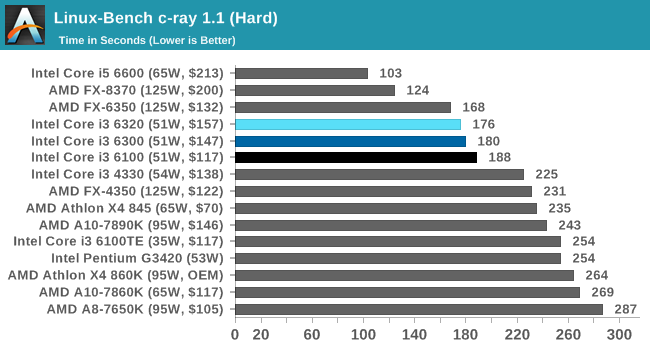
C-Ray is another bench that likes threads and high IPC cores, hence the i5-6600 sits out ahead followed by the FX-8350. At a lower price bracket, the FX-6350 with six threads wins out against the set of Core i3s, which follow their regular staircase pattern. The difference in frequency accounts for 4 seconds difference, and it seems the L3 cache difference accounts for another 4, or about 2%.
NAMD, Scalable Molecular Dynamics: link
Developed by the Theoretical and Computational Biophysics Group at the University of Illinois at Urbana-Champaign, NAMD is a set of parallel molecular dynamics codes for extreme parallelization up to and beyond 200,000 cores. The reference paper detailing NAMD has over 4000 citations, and our testing runs a small simulation where the calculation steps per unit time is the output vector.
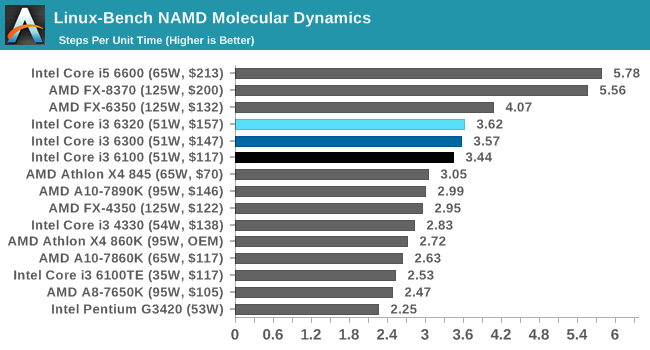
Similarly with NAMD, cores and IPC matter most. The Athlon X4 845 gets a good showing here for a $70 chip, beating the price/performance ratio of the Core i3s. Again, the AMD FX-6350 is ahead of the Core i3s, and the lopsided staircase means that the L3 cache difference accounts for another 2% loss in performance.
NPB, Fluid Dynamics: link
Aside from LINPACK, there are many other ways to benchmark supercomputers in terms of how effective they are for various types of mathematical processes. The NAS Parallel Benchmarks (NPB) are a set of small programs originally designed for NASA to test their supercomputers in terms of fluid dynamics simulations, useful for airflow reactions and design.
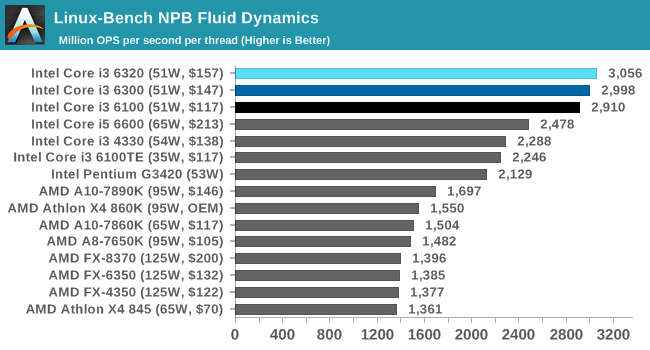
NPB clearly favors Intel CPUs, and the name of the game is IPC and frequency due to the i5 being behind the Core i3 parts. On the AMD side, the highest frequency part takes the lead and the thread count doesn't seem to matter much; neither does the microarchitecture, indicating that NPB is likely tuned for Intel.
Redis: link
Many of the online applications rely on key-value caches and data structure servers to operate. Redis is an open-source, scalable web technology with a strong developer base, but also relies heavily on memory bandwidth as well as CPU performance.
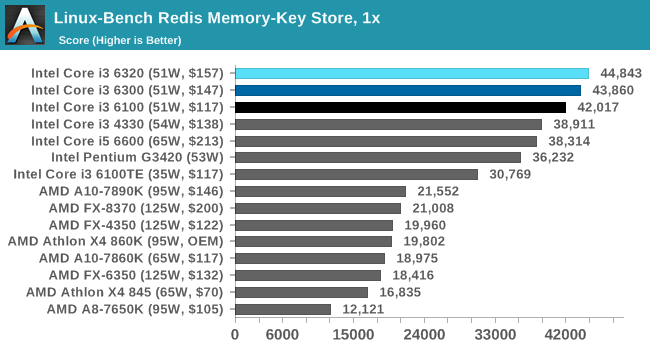

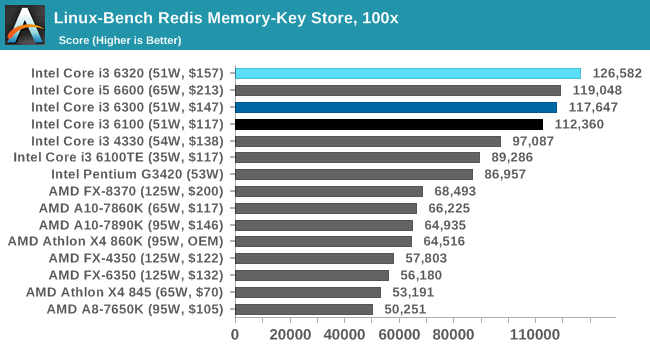
Redis is similar - high IPC and lots of fast cache are needed, and again it seems to be Intel tuned. The i5 sits below the set of Core i3s until the 100x loading comes along, where having physical cores and more cache seems to help. Despite saying more cache seems to help, the effect of the lower L3 cache on the i3-6100 seems to matter more in the 1x and 10x tests, but less in the 100x test, which is somewhat odd.










94 Comments
View All Comments
fanofanand - Monday, August 8, 2016 - link
LOL nice. I believe Cellar Door was stating that bug77's comments were poorly educated. :PStas - Sunday, August 14, 2016 - link
Maybe he's just giving us some examples?bug77 - Tuesday, August 9, 2016 - link
Based on two assumptions (and nothing more), you know for certain my comment is poorly educated. Nice.Dritman - Thursday, August 18, 2016 - link
Explain to me then, the benefit of having a faster system if the speed boost is imperceptible to the user. You also have no insight into how the original commenter is using their system. Grow up.Voldenuit - Tuesday, August 9, 2016 - link
>Neah, I went i5-2500k -> i5-6600k and there's no noticeable difference.In gaming or general applications? If gaming, are you on a 60 Hz display? That could be the biggest bottleneck right there, assuming you have a modern GPU to go with that 6600K.
VeauX - Monday, August 8, 2016 - link
I have no compelling reason to retire my 2500K still. Running at 4.5GHz 24/7 for years, it is still able to swallow everything I throw at it without issues. The only thing would be the feature set of the new Chipsets (M2 etc...) but .... meh...kmmatney - Tuesday, August 9, 2016 - link
Last Xmas I bought my son a 2600K + motherboard for less than ~$200 on Ebay. It may be old, but still runs everything without a hitch, and having 8 threads is great when needed. Intel is competeing against itself, including what you can get used nowadays.eaglehide - Monday, August 8, 2016 - link
The graphs are not clickable on the GTA V page.sheh - Monday, August 8, 2016 - link
ECC only in low-end CPUs?!owan - Monday, August 8, 2016 - link
ECC is a Xeon feature once you moving up Intel's food chain. If you need 4+ cores and ECC, you need to get a Xeon